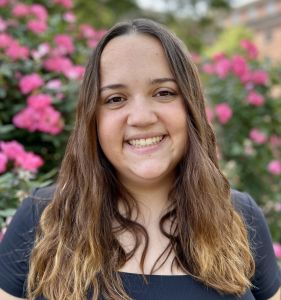Fellowship Boosts UNC Ph.D. Student’s Research on Toxic Aerosols from Harmful Algae

First-year Ph.D. student Samantha Bell has been awarded a prestigious fellowship from the North Carolina Water Resources Research Institute and North Carolina Sea Grant to pursue to pursue research into how volatile organic compounds emitted by harmful algal blooms can react in the atmosphere to create PM2.5—fine particulate matter linked to respiratory and cardiovascular diseases.

May 22, 2025 I By Dave DeFusco
As the warm summer sun heats the still waters of North Carolina’s lakes and rivers, a troubling phenomenon increasingly spreads across their surfaces: thick mats of cyanobacteria, known as harmful algal blooms (HABs), turning freshwater green and noxious. These toxic events, triggered by nutrient pollution and warming temperatures, pose serious risks to human and animal health. Until now, most research has focused on what happens when people ingest or touch the tainted water. But for Samantha Bell, a first-year Ph.D. chemistry student at UNC-Chapel Hill, the concern lies in something far more elusive—and possibly just as dangerous: the air we breathe around these blooms.
Bell has been awarded a prestigious fellowship from the North Carolina Water Resources Research Institute and North Carolina Sea Grant to pursue this novel line of inquiry. Her project, “Determination of Secondary Organic Aerosol Formation from Cyanobacterial Harmful Algal Blooms,” seeks to understand how volatile organic compounds emitted by these blooms can react in the atmosphere to create PM2.5—fine particulate matter linked to respiratory and cardiovascular diseases.
She is one of seven graduate students from universities across North Carolina awarded fellowships through WRRI’s “Mountains to Sea” initiative. Their projects address issues from coastal water quality and stormwater runoff to invasive species and algal blooms. Six fellowships were funded by WRRI and Sea Grant, with one supported by the Stormwater Consortium.
“I spoke to a woman who lives in Edenton near the Chowan River,” said Bell. “She told me that every time there’s a harmful algal bloom, she can’t go outside because of her asthma, even though she lives three blocks from the water. That conversation really stuck with me. It showed me and my advisor, Dr. Jason Surratt, how big this knowledge gap is. There’s barely any research on why people like her can’t breathe during these blooms.”
While Bell acknowledges the importance of studying ingestion and skin contact with HABs, she believes that inhalation exposure has been neglected for too long. Her research focuses on two cyanobacteria-derived volatile organic compounds—β-ionone and β-cyclocitral—known to be released into the air during bloom events.
“These compounds are reactive,” said Bell. “They interact with hydroxyl radicals in the atmosphere and that leads to the formation of secondary organic aerosols. These aerosols can adhere to existing particles in the air and form PM2.5, which can penetrate deep into the lungs.”
Dr. Surratt, who is the Cary C. Boshamer Distinguished Professor of chemistry and environmental sciences and engineering at UNC, praised Bell’s ambition in tackling this complex, multidisciplinary project.
“Samantha’s work is at the intersection of atmospheric chemistry, public health and environmental science,” he said. “She’s filling a real gap in our understanding of how HABs can affect air quality and human health. It’s cutting-edge research with important implications for communities across the state and beyond.”
To mimic the chemical reactions that occur in the atmosphere, Bell uses an oxidation flow reactor, a tool that accelerates atmospheric aging processes in a controlled environment.
“Using a traditional smog chamber would take weeks for one experiment,” she said. “But the oxidation flow reactor lets us simulate those reactions in hours, so we can run many more tests and gather more data. It’s a huge advantage.”
In her experiments, she introduces volatile organic compounds into the reactor and observes how they oxidize and form aerosols when mixed with pre-existing atmospheric aerosol components like acidified ammonium sulfate and calcium carbonate.
“I chose ammonium sulfate because it’s everywhere in the air already—just a common background aerosol,” she said. “Calcium carbonate comes from the lakes themselves, so it makes sense to include it, too. We expect that when these VOCs react in the presence of these -pre-existing particles, they’ll form larger quantities of PM2.5, which could be even more harmful.”
Bell’s study also aims to identify chemical tracers—unique compounds that can signal when PM2.5 is originating specifically from HABs. These tracers could help regulators and scientists monitor air pollution related to freshwater blooms.
“If we can show that these tracer compounds are present in the field samples that I’ll be collecting from lakes, then we can build a case that HABs are directly contributing to PM2.5 formation,” she said. “That could push more research and policy to protect people who live near these bodies of water.”
Receiving the WRRI fellowship has had a major impact on Bell’s academic path. “It’s a little overwhelming—being a first-year Ph.D. student is no joke,” she said. “But I’m really excited to have such a well-defined project this early on. I didn’t think I’d be this far along already, and it’s really motivating.”
For Bell, the ultimate goal of her research is not just academic—it’s personal and practical, meant to empower people in Edenton and others living near North Carolina’s freshwaters. She cited a Harmful Algal Bloom Reporting Dashboard on the North Carolina Department of Environmental Quality website, which encourages people who live near a bloom to report it. That data helps regulators understand the frequency and severity of these events.
“We know these blooms are getting worse,” she said. “The more we understand how they affect our air—and our health—the better we can protect the people who live near them.”

